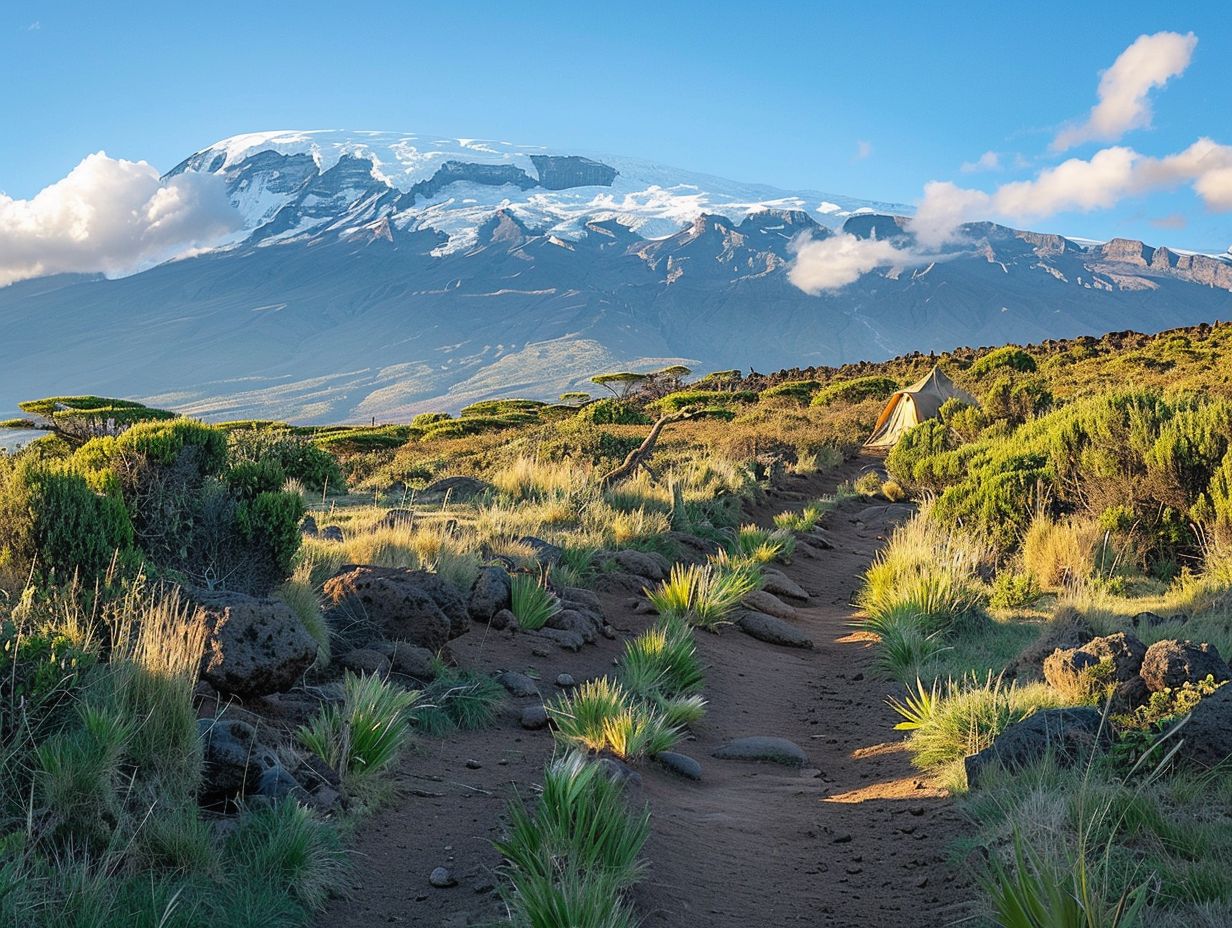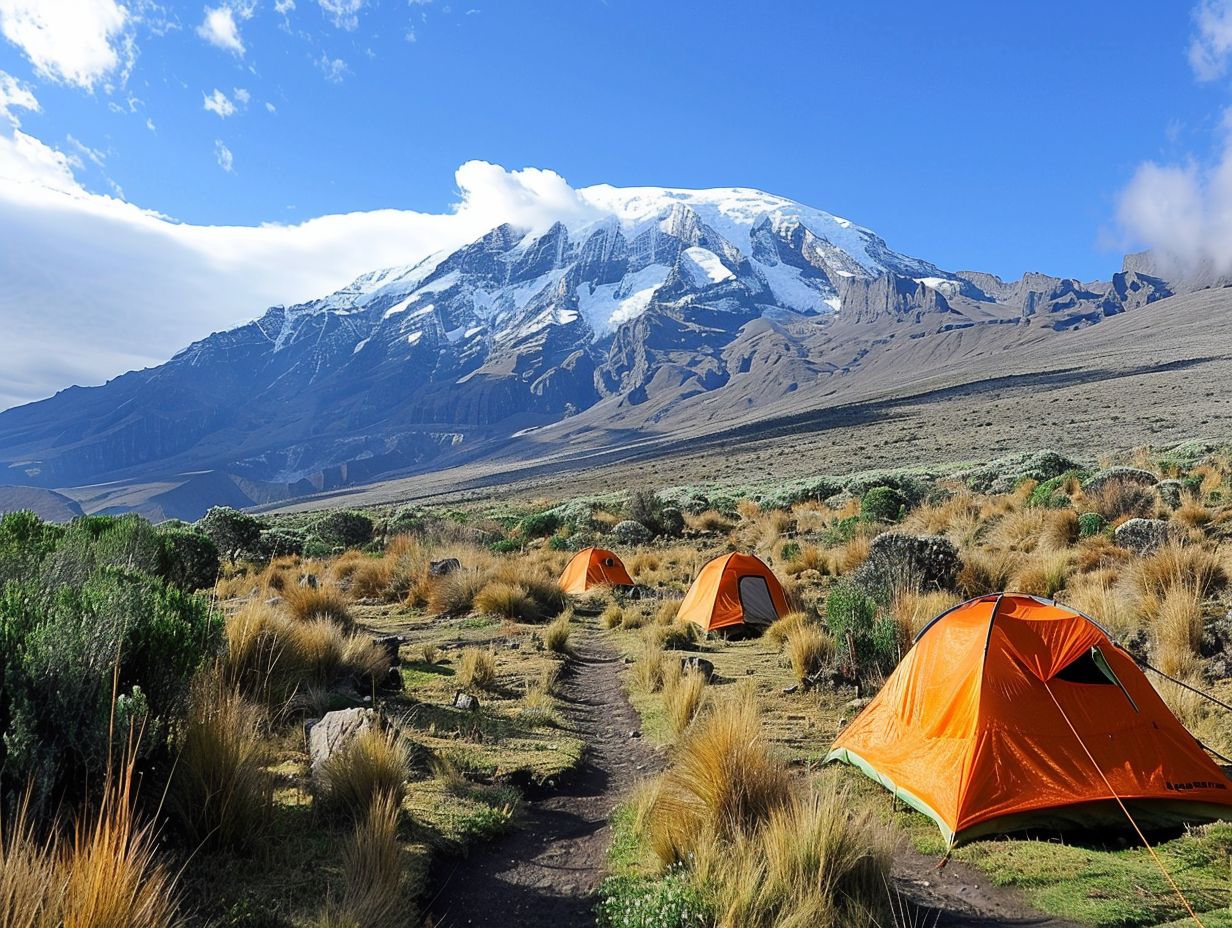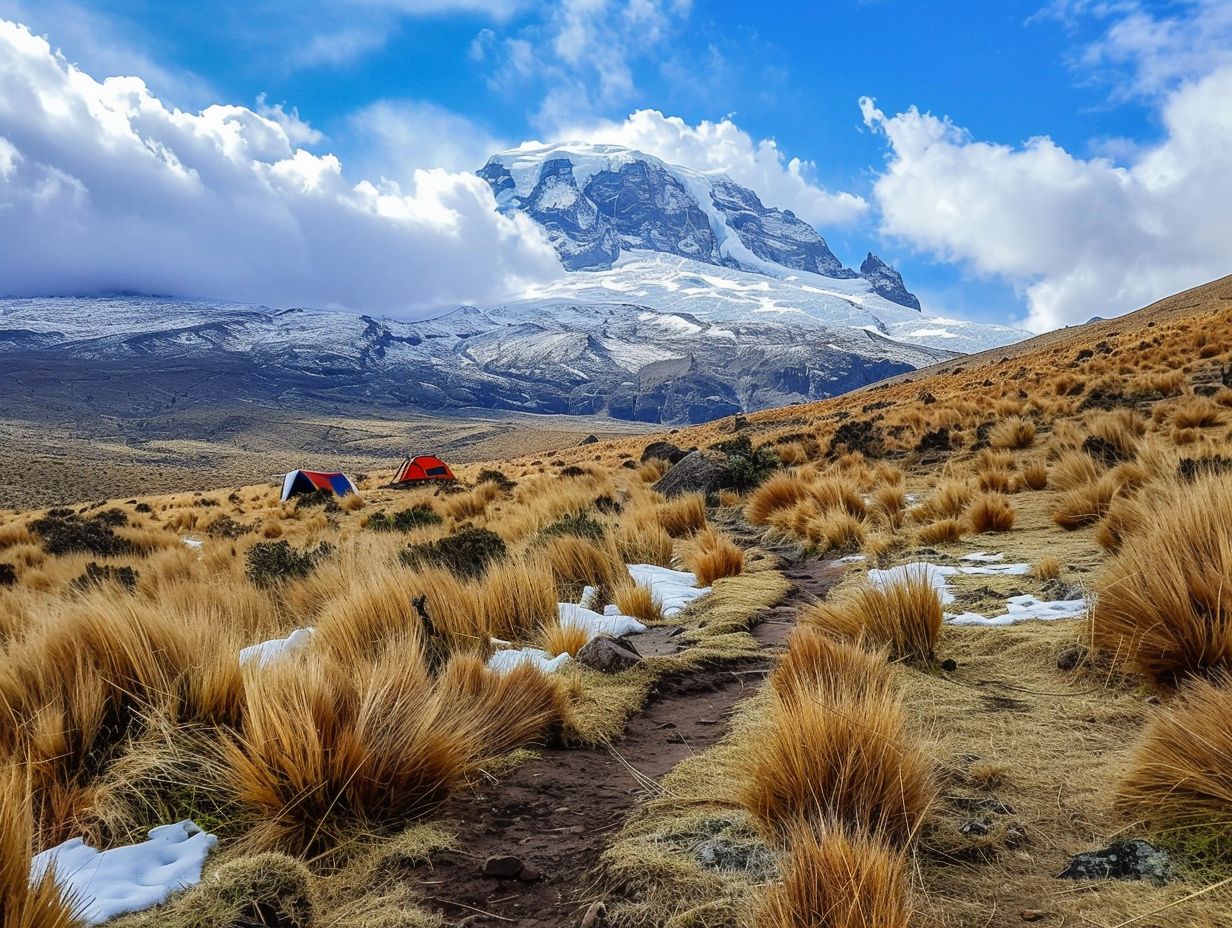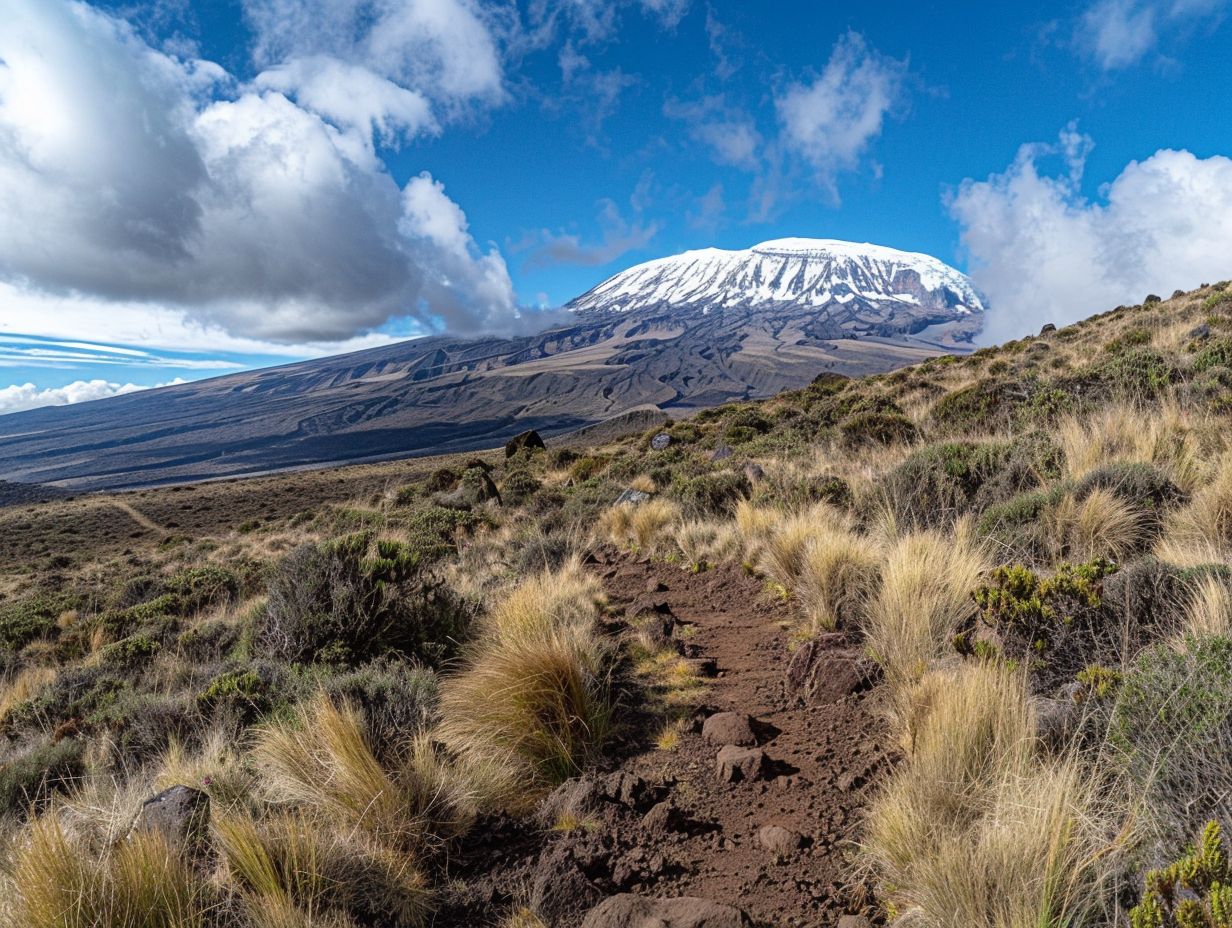
Are you looking to conquer the majestic Mount Kilimanjaro?
Consider the Crater Camp Route, one of the most exhilarating routes.
We provide an overview of this challenging yet rewarding route, including its length, difficulty level, highlights, best time to climb, and how to prepare physically and mentally.
Get ready for an unforgettable adventure on the Crater Camp Route!
Key Takeaways:

- The Crater Camp Route is one of the most challenging routes to climb Kilimanjaro, with its highlight being the breathtaking scenery of the summit crater.
- To successfully complete the Crater Camp Route, climbers should have a good level of physical fitness and the necessary gear and equipment.
- The best time to climb the Crater Camp Route is during the dry season from June to October, but climbers should also be prepared for colder temperatures at higher altitudes.
Crater Camp Route: An Introduction
The Crater Camp Route stands out as a challenging yet rewarding path to the summit of Kilimanjaro, offering breathtaking views of the Furtwangler Glacier and the Ash Pit.
Considered one of the more technical routes on Kilimanjaro, the Crater Camp Route demands a high level of fitness and altitude acclimatization due to its steep ascents and rugged terrain. Climbers are treated to panoramic vistas of the surrounding plains and valleys as they make their way through the alpine desert zone, passing unique volcanic formations along the way.
The trail to Crater Camp itself is peppered with volcanic ash, giving it an otherworldly feel that adds to the allure of this challenging journey. As adventurers advance towards the summit, the imposing glaciers of Kilimanjaro loom large, creating a stark yet mesmerizing contrast against the blue skies.
What Is The Length Of The Crater Camp Route?
The Crater Camp Route spans a challenging distance, leading climbers through diverse landscapes and altitudes to reach the highest campsite near the stunning Reusch Crater. This trek offers a blend of physical endurance and scenic beauty, making it a memorable journey for adventurers.
The route covers a total distance of approximately 20 miles, taking hikers through lush forests, rocky terrain, and finally to the breathtaking vistas near the Reusch Crater campsite. Notable campgrounds along the way include the picturesque Serene Valley Camp and the rugged Summit Base Camp, each offering unique experiences and perspectives of the surrounding landscapes.
Reusch Crater campsite itself is perched at an impressive altitude, providing panoramic views of the surrounding peaks and valleys, making it a rewarding destination for those seeking high-altitude camping adventures.
What Is The Difficulty Level Of The Crater Camp Route?
The Crater Camp Route presents a challenging ascent with varying degrees of difficulty, testing climbers’ endurance and altitude tolerance. Acute Mountain Sickness (AMS) can pose a risk, requiring proper acclimatization and physical preparedness to overcome the route’s obstacles.
At elevations exceeding 5,000 meters, climbers often encounter thin air, extreme weather fluctuations, and steep rocky terrain that demand mental fortitude and physical resilience. The unpredictable nature of high-altitude environments adds another layer of complexity to the climb, with climbers having to navigate crevasses, icy patches, and potentially dizzying ledges.
The psychological challenge of pushing oneself beyond comfort zones amidst the breathtaking but unforgiving landscape can be daunting. Without adequate acclimatization, climbers face a heightened risk of succumbing to AMS, characterized by symptoms such as headaches, nausea, and fatigue that can quickly derail an ascent.
What Are The Highlights Of The Crater Camp Route?

The Crater Camp Route boasts captivating highlights, including panoramic views of the Furtwangler Glacier, the Ash Pit, and the unique campsite experiences along the trek. Climbers can witness the grandeur of Kilimanjaro’s glaciers and geological formations while immersing themselves in a challenging yet rewarding expedition.
As climbers ascend along the Crater Camp Route, they are greeted with staggering vistas of the vast glaciers that adorn the landscape, creating a mesmerizing contrast against the clear blue skies. The trek offers a blend of adventure and natural beauty, with the Ash Pit standing as a stark reminder of the volcanic origins of the region, adding an intriguing geological aspect to the journey.
The campsite experiences on this route are nothing short of unforgettable, with each stop providing a new perspective of the surrounding terrain. The diverse flora and fauna encountered along the way add a touch of vibrant life to the rugged, icy scenery, making every step a discovery in itself.
What Is The Best Time To Climb The Crater Camp Route?
Choosing the best time to climb the Crater Camp Route is crucial for a successful and enjoyable expedition. The optimal climbing season ensures favorable weather conditions, clear views of the surroundings, and enhanced safety for climbers navigating the challenging terrain.
During the ideal climbing season, which typically falls during summer and early fall, climbers can expect stable weather patterns with minimal precipitation, reducing the risk of sudden storms or freezing temperatures that could jeopardize the ascent. Clear skies during this period provide breathtaking panoramic vistas of the surrounding landscape, including majestic peaks and the stunning Caldera.
Safety is paramount when tackling the Crater Camp Route, and climbing during the optimal season allows for better visibility, safer trail conditions, and increased chances of successful rescue operations in case of emergencies.
Planning your expedition during the peak months when the weather is most predictable and conducive to climbing can significantly enhance your overall experience and ensure a memorable journey to the summit.”
How To Prepare For The Crater Camp Route?
Proper preparation is key for conquering the challenges of the Crater Camp Route, requiring climbers to focus on physical fitness, altitude acclimatization, and essential gear.
Hiking experience and endurance training play a vital role in ensuring a successful and safe journey to the summit. Altitude adaptation is crucial as climbers ascend to higher elevations where oxygen levels decrease, leading to potential altitude sickness.
It is recommended to gradually acclimatize by spending a few days at intermediate altitudes before attempting the summit. Along with physical training, mental preparation is equally important for facing the demanding terrain and weather conditions of the route.
What Are The Physical Requirements For The Crater Camp Route?
The Crater Camp Route demands robust physical fitness due to the high altitude and challenging terrain encountered during the ascent. Climbers must train for endurance, strength, and stamina to tackle the rigors of the journey effectively, ensuring a safe and rewarding climbing experience.
At an elevation exceeding 15,000 feet, climbers face reduced oxygen levels and harsh weather conditions, making acclimatization crucial. The altitude brings challenges like fatigue, shortness of breath, and potential altitude sickness, requiring proper preparation. Training regimens should include cardiovascular exercises, uphill hiking, and strength training to build physical resilience.
The rocky and sometimes icy terrain calls for agility, balance, and lower-body strength. Backpack weight from carrying essential gear adds to the physical demands, making it essential to strengthen core muscles and back for stability and endurance. Endurance training becomes paramount as climbers aim to summit and descend safely.
What Gear And Equipment Are Needed For The Crater Camp Route?
The Crater Camp Route necessitates specialized gear and equipment to navigate the rugged terrain and extreme conditions, including high-quality hiking boots, thermal clothing, trekking poles, and essential camping gear. Proper equipment ensures climbers’ safety and comfort throughout the challenging expedition.
Key considerations when selecting gear for this adventure include sturdy hiking boots with good ankle support to prevent injuries on uneven ground. Multiple layers of thermal clothing are crucial to stay warm in fluctuating temperatures common at high altitudes.
Trekking poles assist in maintaining balance and reducing strain on knees during descents. Essential camping gear like a high-quality tent, sleeping bag rated for cold weather, and camp stove for meals are essential for overnight stays in the wilderness.
What Is The Recommended Training Plan For The Crater Camp Route?
A well-rounded training plan is essential to prepare for the physical and mental demands of the Crater Camp Route expedition. Climbers should focus on cardio, strength training, and altitude simulation exercises to build endurance and resilience for the challenging ascent to Kilimanjaro’s summit.
For cardio workouts, incorporating activities such as running, cycling, and stair climbing into your routine can help improve cardiovascular fitness, essential for sustained energy during the climb. Strength training, including bodyweight exercises, weightlifting, and core workouts, aids in muscle development and overall body strength.
Altitude training is crucial to acclimate your body to the reduced oxygen levels at higher elevations, simulating the conditions you will face on Kilimanjaro.
What Is The Itinerary For The Crater Camp Route?

The Crater Camp Route’s itinerary meticulously outlines the journey from Marangu Gate to Mandara Hut, progressing through scenic campsites and acclimatization stops before culminating in the exhilarating summit bid to Uhuru Peak. Each day offers unique challenges and breathtaking views, ensuring a memorable climbing experience.
As climbers venture from Mandara Hut to Horombo Hut, the landscape transforms, offering glimpses of the stunning Kilimanjaro scenery. Following a night at Horombo, the next leg leads to Kibo Hut, strategically positioned for the final push.
The ascent to Gilman’s Point rewards with a surreal sunrise, paving the way for the ultimate trek to Uhuru Peak. Descending back to Horombo Hut, trekkers celebrate their conquest before the final descent to Marangu Gate, reflecting on their incredible accomplishment.
Day 1: Start at Marangu Gate to Mandara Hut
The Crater Camp Route commences with an energizing start from Marangu Gate, leading climbers towards the serene Mandara Hut campsite. Day 1 sets the tone for the expedition, offering a glimpse of the natural beauty and challenges awaiting on the ascent to the summit.
As climbers embark on this exhilarating journey, they are enveloped by the lush rainforest, alive with the calls of exotic birds and the rustling of the leaves beneath their feet. The trail meanders through a variety of landscapes, from dense vegetation to rocky outcrops, providing a diverse visual feast for the senses.
Arriving at the Mandara Hut campsite, the weary trekkers are greeted by the cozy wooden cabins nestled among the towering trees. The sight of the mist rolling in over the nearby hills adds a mystical charm to the evening atmosphere, setting the stage for a night of rest and camaraderie under the starlit African sky.
Day 2: Mandara Hut to Horombo Hut
On Day 2 of the Crater Camp Route, climbers progress from the Mandara Hut to the picturesque Horombo Hut campsite, traversing diverse terrain and enjoying scenic vistas along the way. This leg of the journey offers a blend of challenges and natural wonders, enhancing the overall climbing experience.
The trek from Mandara Hut to Horombo Hut on Day 2 is characterized by a gradual ascent through lush vegetation, providing climbers with a refreshing start to the day. As the journey unfolds, the landscape transitions into rocky terrain, testing the climbers’ agility and endurance. The Horombo Hut campsite, nestled on a slope with stunning views of the surrounding mountain ranges, offers a serene setting for outdoor enthusiasts to unwind and connect with nature.
Facilities at Horombo Hut include cozy bunkhouses, dining areas serving hearty meals, and clean restroom facilities, ensuring climbers have a comfortable stay amidst the rugged wilderness. In the evening, climbers can witness breathtaking sunsets casting a golden hue over the expansive plains below, creating a surreal backdrop for shared campfire stories and camaraderie among fellow adventurers.
Day 3: Acclimatization Day at Horombo Hut
Day 3 of the Crater Camp Route is dedicated to acclimatization at the Horombo Hut campsite, allowing climbers to adjust to the altitude and prepare for the challenging ascent ahead. This vital rest day ensures climbers’ well-being and readiness for the subsequent stages of the expedition.
At Horombo Hut campsite, climbers engage in shorter hikes to higher altitudes to help their bodies gradually acclimate to the reduced oxygen levels. This gentle introduction to the increasing elevation reduces the risk of altitude sickness and maximizes the chances of a successful summit attempt.
The campsite’s comfortable facilities offer a soothing environment for relaxation and recovery, allowing climbers to recharge both physically and mentally. It’s a crucial phase where individuals listen to their bodies, hydrate adequately, and enjoy the stunning panoramas of the surrounding landscapes.
Day 4: Horombo Hut to Kibo Hut
The journey on Day 4 of the Crater Camp Route leads climbers from the Horombo Hut to the elevated Kibo Hut campsite, providing a strategic position for the final push towards the summit. This leg of the expedition tests climbers’ endurance and determination as they approach the majestic Kibo Crater.
As climbers ascend to the Kibo Hut campsite located at approximately 4,700 meters, they experience the effects of higher altitudes, requiring them to pace themselves and maintain proper hydration to combat altitude sickness. The stunning views of the rugged terrain and the vast expanse below offer a breathtaking backdrop to their challenging journey.
Upon reaching the Kibo Hut, climbers find refuge in the basic yet vital facilities that include dormitory-style accommodations and communal dining areas. The sense of camaraderie among fellow climbers enhances motivation and support for the strenuous climb ahead.
Day 5: Summit Day – Kibo Hut to Uhuru Peak and back to Crater Camp
Day 5 marks the pinnacle of the Crater Camp Route as climbers embark on the exhilarating summit bid from Kibo Hut to the iconic Uhuru Peak, Kilimanjaro’s highest point.
The ascent to the summit of Uhuru Peak is a culmination of determination, perseverance, and sheer willpower. As climbers push through the final stretch, the air thins, hearts race, and the sense of accomplishment grows stronger with every step closer to the peak. Upon reaching the summit, a flood of emotions washes over the climbers – joy, relief, and an overwhelming sense of achievement as they stand on the ‘Roof of Africa’.
Day 6: Crater Camp to Horombo Hut

On Day 6 of the Crater Camp Route, climbers descend from the Crater Camp back to the Horombo Hut, retracing their steps through familiar terrain and recalling the challenges and triumphs of the ascent. The descent offers a chance to appreciate the mountain’s beauty from a different perspective.
The return journey from Crater Camp to Horombo Hut is a poignant moment that allows climbers to soak in the grandeur of Kilimanjaro from a new angle. As they make their way down the well-trodden path, memories of conquering the challenging ascent resurface, reminding them of their resilience and determination.
Descending through the rugged landscape, climbers are greeted by sweeping panoramas of lush valleys and distant peaks, serving as a serene backdrop to their reflections on the journey. The descent, though physically demanding, carries a sense of fulfillment and nostalgia as climbers bid farewell to the altitude and harsh conditions.
Day 7: Horombo Hut to Marangu Gate
The final day of the Crater Camp Route culminates in a descent from Horombo Hut to Marangu Gate, marking the completion of the awe-inspiring climbing expedition. Climbers bid farewell to Kilimanjaro, cherishing the memories and achievements gained during the journey.
As climbers begin their journey back down the trails, they soak in the last glimpses of the towering peaks bathed in the morning light, a sight that will forever be etched in their minds.
Reflection becomes a companion on the way down, contemplating the challenges faced, the camaraderie built, and the sheer determination that pushed them forward.
Each step taken brings them closer to the base, symbolizing the end of this remarkable adventure. The bustling atmosphere at Marangu Gate greets them, a stark contrast to the serene mountain paths. Here, certificates of achievement are awarded, officially marking the climbers’ triumph over Mount Kilimanjaro.
Frequently Asked Questions
What is the Crater Camp Route on Kilimanjaro?
The Crater Camp Route is a lesser-known trail on Mount Kilimanjaro that leads hikers to the summit through the nearby Reusch Crater. It is a beautiful and challenging route that offers stunning views and a more secluded experience.
How difficult is the Crater Camp Route on Kilimanjaro?
The Crater Camp Route is considered a difficult route, requiring a high level of physical fitness and endurance. The steep ascents and descents, as well as the high altitude, make it a challenging trek for even experienced hikers.
How long is the Crater Camp Route on Kilimanjaro?
The Crater Camp Route is approximately 42 kilometers (26 miles) long, making it one of the shorter routes on Kilimanjaro. However, it is still a strenuous trek and typically takes 6-7 days to complete.
What is the best time to hike the Crater Camp Route on Kilimanjaro?
The best time to hike the Crater Camp Route is during the dry season, from June to October, and January to February. The weather is generally clear and dry during these months, making for better hiking conditions and stunning views.
Do I need any special equipment for the Crater Camp Route on Kilimanjaro?
Yes, hikers on the Crater Camp Route will need to bring all the necessary hiking and camping gear, including a good quality sleeping bag, warm clothing, and hiking boots. In addition, a high-altitude sleeping bag and walking poles are recommended due to the challenging terrain and high altitude.
Is the Crater Camp Route on Kilimanjaro safe?
The Crater Camp Route is generally considered safe, but like any high-altitude trek, it does come with risks. It is important to choose a reputable tour company and follow their safety guidelines, including taking the necessary acclimatization breaks and following the guidance of your guide. In case of any emergencies, there are rescue teams available on the mountain.